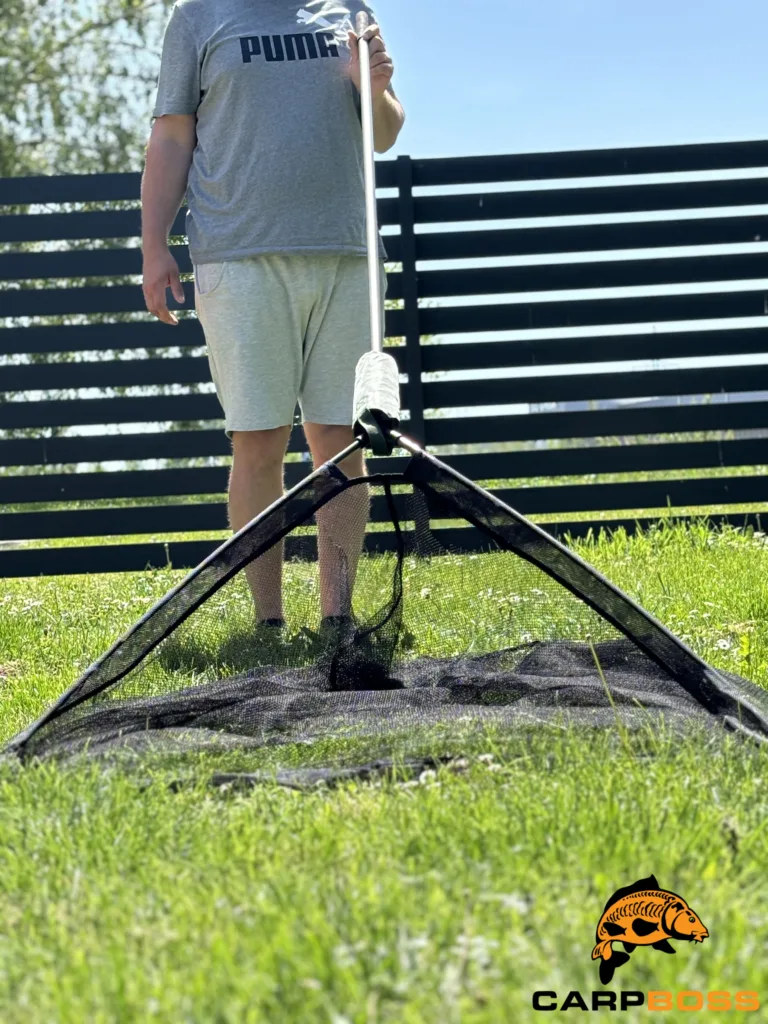When it comes to fishing, having the right equipment is essential for a successful catch. One important piece of gear is the landing net handle, which plays a crucial role in safely netting and landing fish. In this article, we will discuss this broad topic. Specifically, we will answer the question about what length landing net handle is ideal for various types of fishing.
Importance of a Properly Sized Landing Net Handle
Choosing the proper length of the handle is crucial and can make all the difference between a successful fishing day and a bad one. A right handle can make a significant difference in efficiently landing fish.
One key consideration when choosing the length and deciding between handle types is to know which fish species you’ll be landing and in which conditions. Challenging conditions such as high river banks, marginal reeds, and weed beds are something you should keep in mind.
So, investing in a properly sized landing net handle can enhance the fishing experience. It will provide the necessary reach, strength, and adaptability required for a perfect landing while at the same time ensuring the safety of both the angler and the fish.
Shorter Landing Net Handles vs. Longer Ones
Advantages and Disadvantages of Shorter Handles
Short handle nets are perfect for anglers who fish in smaller waters or need to navigate through thick brush. These nets are lightweight and their small transport size makes them ideal for hopping from stream to stream. However, shorter handles and smaller baskets can lead to longer fight times and more difficulty landing larger fish.
But truth be told, these are most commonly used for spinning from a boat. Unlike carp fishing, this style of fishing means you’ll be landing species such as Asp, Pike, or Walleye. These tire easily and the hoop will be large enough to land them safely. the
Advantages and Disadvantages of Longer Handles
Longer handles allow anglers to reach further, shortening the fight with the fish and improving success rates. This also means less stress on the fish due to quicker netting, promoting healthier catch and release practices. Longer handles are ideal to land fish species like Muskie, Carp, Grass Carp, or Catfish.
On the other hand, even when you have a detachable handle, they can be cumbersome and require more space for transport. Also, if you are fishing bass or trout, these may not be necessary and they’ll only reduce your mobility while looking for your trophy fish.
The Role of Handle Length in Landing Different Fish Species
Consideration for Catching Trout and Salmon
When it comes to landing trout or salmon which which are often hooked through a fly fishing method, logically, you’ll use fly fishing nets. These nets have a circular shape hoops and handles on are not longer than 8-10 inches. That is okay because you need a strong grip on the handle and you’ll find yourself in the trout streams very often. Trying to maneuver in such a situation with a two-piece telescopic handle wouldn’t be very fun.
Consideration for Catching Carp
Since I am mostly writing about carp fishing, this section will be interesting to the majority of the users. For carp, you’ll need a larger hoop size, preferably between 42 and inches. Big carp will almost certainly be reeled in from a great distance and you’ll find yourself on a steep bank regularly.
That’s why you’ll want to have a long and light, but strong handle capable of carrying such a big hoop without bending too much or sinking immediately when you put it on the water’s surface.
Speaking of this beautiful fish, take some time and learn what’s so special about carp fishing from a boat.
Consideration for Catching Bass
Bass fishing is specific because you can find yourself in a wide range of situations when you are fishing for it. But, in most cases 48-inch handle should be enough as long as you are using normal sized hoop. When I say “normal”, I mean a hoop between 32 and 36 inches.
Also, your landing net should be knotless so your fishing tackle doesn’t get tangled in the mesh or even worse, your hooks.
Types of Landing Net Handles
These days, we have a wide range of types and materials from which the handles are made. Which one you choose depends solely on your preference and the landing net usage. But, keep in mind that the type of handle is one of the factors when you are choosing what length for landing net handle to use.
Wood Handles
A whole variety of woods can be used for handle making. Typically, wooden handles cannot be detached and they are fixed to the landing next to themselves. Additionally, landing nets with wooden handles are most commonly short with a small hoop. Their main purpose is to use them for boat fishing, even when the boat size is very small.
Carbon Handles
These handles made out of carbon fibers are most commonly used in carp fishing. They come in different lengths and sometimes can come in 2 or 3 pieces. The biggest advantage of these handles is resilience, strength, and durability.

Telescopic Handles
Handles from this category are all-around handles that can be utilized for any fishing technique. They are easy to transport because even a 1.8 m three-part telescopic handle can easily fit into your car. After all, it takes only 70cm when it’s folded.
The material from which these handles are made is most commonly twin layer carbon or plastic.
Detachable Handles
Last on the list are detachable handles. Loved by the anglers because they are very practical. Modern ones fit on any hoop size or shape. Another advantage is that alongside the ability to remove them from the hoop at will, they can also come in one fixed length or can be telescopic.
In essence, the answer to the original question of what length of landing net handle should you go for depends solely on your needs and preferences. So just pick out what suits you best. Take care of your landing nets by regularly cleaning them and make sure that no hooks get tangled in the mesh because that can damage the net and cause problems in the long run.
